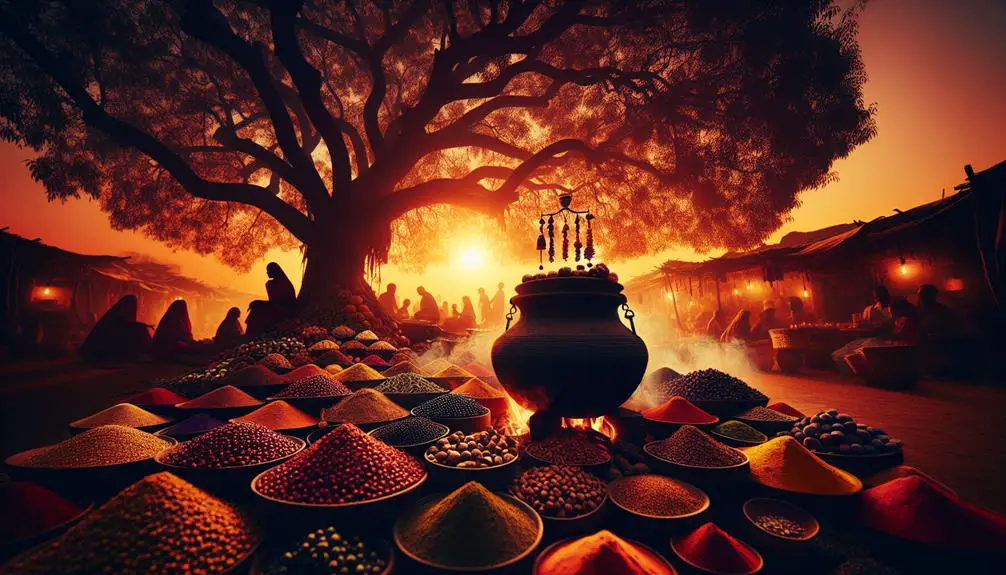The chicken curry is a tasty dish that originated in ancient kitchens and has evolved over time with different spices and flavors.
It has become popular in many countries and is enjoyed by people around the world.
The recipe has varied in different cultures, with each adding its own unique touch to the dish.
Origin of Chicken Curry

You’ll find that spices and herbs have been pivotal in cooking since ancient times, with trade routes significantly impacting culinary practices.
As you explore the birth of curry, you’ll uncover how this term has evolved and how curry-like dishes appeared in historical records.
Grasp the significance of these early culinary traditions as they set the stage for what would become a global phenomenon.
Early Use of Spices and Cooking Techniques
Ancient cooking was really influenced by spices and herbs. People from different places traded spices and ideas about cooking.
They used cool techniques to make the spices taste even better, like drying and roasting them.
Spices were super important and valuable – people even fought over them! The spice trade changed the world and helped us discover new flavors. That’s why we can enjoy tasty dishes like chicken curry today.
The Birth of Curry
Let’s talk about how the word ‘curry’ came about and changed over time.
The word ‘curry’ comes from the Tamil word ‘kari,’ which means sauce. People have been making spiced meat dishes since 1700 BC, and this idea was found in a recipe near Babylon in Mesopotamia.
In India, ‘curry’ usually means a spicy stew or gravy with a sauce base. The British changed Indian food and made curry powder, which is a mix of spices like turmeric, cumin, and coriander.
Now, curry is a popular dish all around the world.
The Genesis of Chicken Curry

You’ll find the roots of chicken curry deep in Indian history, where early cooks combined chicken with a medley of spices to create this vibrant dish.
As traders and travelers took these recipes beyond India’s borders, Southeast Asian countries like Thailand and Malaysia embraced and added their unique twists.
This cross-cultural journey transformed chicken curry into a global phenomenon with countless regional interpretations.
Indian Origins
Chicken curry in India has been around for a super long time. People in India really liked using spices in their cooking, like cardamom and black pepper, and they even got some spices from other places through trade, like cinnamon.
Indian cooks were already mixing all these spices together way back in 3000 BC, kind of like making curry.
They also started using chicken in their cooking a long time ago. Like in the 1500s, the fancy kitchens were making a dish called Murgh Mussallum, which is kind of like curry but not really.
They were really good at using the stuff they’d around them to make all different kinds of chicken curries that we still enjoy today.
Spread to Southeast Asia and Beyond
Chicken curry recipes from India went to places like Thailand and Malaysia.
In Thailand, they make Gaeng Gai, a curry with coconut milk and lemongrass. It’s spicy and sweet because they use chilies and palm sugar.
In Malaysia, they make curry ayam with a special paste called rempah. This paste has turmeric, galangal, and candlenuts.
These countries use their own herbs and spices to make the chicken curry special.
Regional Variations

You’ll find that Indian chicken curry doesn’t stick to just one recipe; it boasts a myriad of forms across regions like the creamy North Indian curries, fiery South Indian dishes, and the aromatic Bengali versions, each with their distinct spices and cooking techniques.
Turning to Southeast Asia, you’re in for a treat with Thai green curry, Malaysian renditions, and the rich, slow-cooked Indonesian rendang, all bursting with local herbs and unique blends.
Let’s explore these regional twists that elevate the humble chicken curry to an art form in every kitchen they grace.
Indian Chicken Curry
Let’s learn about Indian chicken curry!
There are different kinds from North India, South India, and Bengal.
In the North, they use thick sauces and cream in dishes like Butter Chicken.
In the South, they use tamarind and coconut milk in curries like Chettinad Chicken.
In Bengal, they use mustard oil and a special five-spice blend.
Each place has its own special way of making chicken curry!
Southeast Asian Chicken Curry
When you eat chicken curry from India, it has spices like tamarind and coconut.
But in Southeast Asia, they make different kinds like Thai green curry, Malaysian chicken curry, and Indonesian rendang. Each one has its own special flavors.
Thai green curry is green and tastes fresh, zesty, and a little sweet because of the green chilies, lemongrass, galangal, and kaffir lime leaves.
Malaysian chicken curry has lots of spices and creamy coconut milk with star anise and cinnamon for a nice smell.
Indonesian rendang is slow-cooked and has a rich, earthy flavor from coconut, turmeric, ginger, and other spices.
Cultural Significance

Chicken curry isn’t just a meal; it’s a piece of cultural heritage that spices up festivals and family events.
You’ll find it steeped in symbolism across various religions and woven into the fabric of daily life and special occasions.
Whether it’s a simple family dinner or a grand festival, this dish holds a place of honor on the table, reflecting traditions and shared histories.
Culinary Traditions and Festivals
Chicken curry is like a really important food in lots of cultural parties and stuff. It’s all about being friendly and sharing meals together.
In India, they’ve it for Diwali and weddings, and each place adds its own flavors. In the Caribbean, they’ve it for Carnival and it’s got special local tastes.
No matter where you are, chicken curry is more than just food, it’s like a party on a plate!
Symbolism in Religion and Daily Life
Chicken curry is a dish that holds significant cultural importance in various societies.
In Hinduism, it is more than just a delicious meal; it embodies a unique blend of spices, each symbolizing a vital concept.
For instance, turmeric represents purity, cumin signifies loyalty, and coriander represents love.
This dish holds such significance that it is often offered to deities and shared with others during major celebrations such as Diwali.
However, chicken curry is not reserved solely for special occasions; it is also a regular feature in family dinners.
More than just a means of sustenance, chicken curry serves as a way to preserve traditions and foster togetherness among people.
Modern Adaptations and Global Appeal

You’ve likely noticed chicken curry’s rise to global fame, now featured on menus from Tokyo to Toronto, appealing to a myriad of taste preferences.
Chefs worldwide are reimagining this classic dish, creating healthier versions and even blending it with other culinary traditions to craft exciting fusion dishes.
This widespread adoption speaks to chicken curry’s versatility and its ability to transcend cultural boundaries.
Global Adoption of Chicken Curry
Chicken curry is super famous all around the world! It started in South Asia but now you can find it in lots of restaurants everywhere.
It’s so yummy and lots of people like it because it has different flavors. Some people like it spicy and some like it mild. Chefs can change it to fit what people like where they live.
It’s like a food that brings everyone together from different places.
Contemporary Culinary Trends
Chicken curry has changed a lot in the modern times. Chefs are making it healthier by using lean chicken and adding lots of veggies.
They’re also mixing in new flavors from around the world, like making Thai curry pizza and Japanese katsu curry tacos.
Instead of heavy cream, they use coconut milk, and instead of white rice, they use quinoa or cauliflower rice.
These changes keep the yummy taste of the original but also make it better for people who want to eat healthier.
Wrapping Up
The story of chicken curry is super cool! It started a long time ago and has changed a lot over the years because of different cultures.
Now it’s like a mix of lots of yummy foods from all over the world.
So when you eat chicken curry, remember it’s not just a meal, it’s a story about people and food from everywhere.
